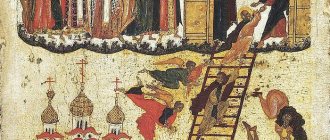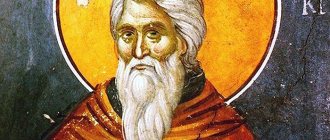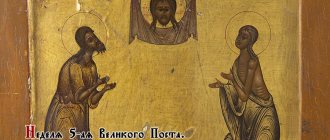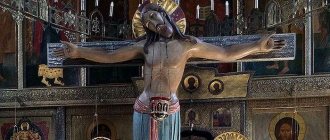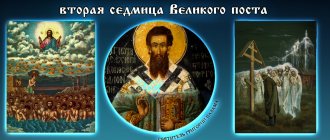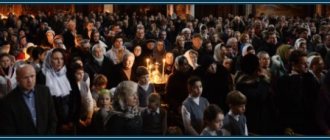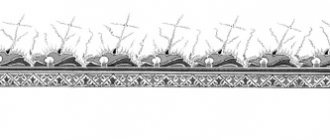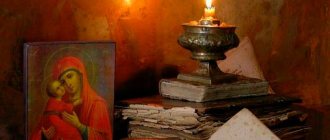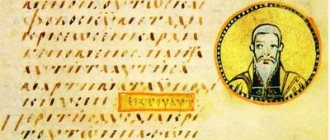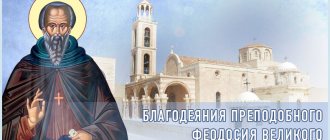On the fourth Sunday of Great Lent, the Holy Church honors the memory of St. John Climacus , abbot of Mount Sinai. This great devotee of piety is known as the author of The Ladder , a classic guide to spiritual life. The memory of the Monk John Climacus is also celebrated on April 12 (March 30, old style).
The life and works of St. John Climacus
The Monk John Climacus was born in Constantinople. The exact date of his birth is unknown, but it is believed to have been in the year 570. In his youth, John received a good education. At the age of 16, he came to Egypt to Mount Sinai and chose a mentor for himself, Elder Martyrius. After some time, he was tonsured a monk. One of those present at the tonsure, Elder Stratigios, predicted that John would become a great lamp of the Church of Christ. For 19 years the monk John labored in obedience to his spiritual father. After the death of Martyrius, John chose a hermit's life, retiring to the deserted place of Fola, where he spent 40 years in complete silence, fasting, prayer and tears of repentance.
The Monk John had a disciple, the monk Moses. One day, John ordered Moses to bring soil to the garden for garden beds. Carrying out this obedience, the monk Moses, due to the intense summer heat, lay down to rest under the shade of a large cliff. John was at this time in his cell and resting after a long prayer. Suddenly a certain handsome man appeared to him and, waking up the ascetic, said: “Why are you, John, calmly resting here, while Moses is in danger?” John immediately woke up and began to pray for Moses. When he returned, John asked if anything bad had happened to him. The monk replied that he was almost crushed by a large piece of stone that came off the cliff under which he had fallen asleep. But in a dream he imagined that John was calling him, and he jumped up and began to run, and at that time a stone fell on the place where he was sleeping.
John had a high, insightful mind, was wise with deep spiritual experience, he lovingly taught everyone who came to him, leading them to salvation. But envious people appeared in his circle, reproaching him for his verbosity, which they explained by vanity. John took upon himself the feat of silence, so as not to give rise to condemnation, and remained silent for a year. The envious people realized their error and themselves turned to the ascetic with a request not to deprive them of the spiritual benefits of the interview. Hiding his exploits from people, John sometimes secluded himself in a cave, but the fame of his pious life spread far beyond the boundaries of the place of exploits, and visitors of all ranks and statuses constantly came to him, eager to hear the word of edification and salvation.
After forty years of asceticism in solitude, John was elected abbot of the Sinai monastery. For about four years he ruled the monastery of Sinai. The Lord endowed John by the end of his life with the grace-filled gifts of clairvoyance and miracles. John reposed in 649 at the age of 80. The location of John's relics is unknown. The Life of John was compiled several years after his death by the monk of the Raifa monastery Daniel , his friend and contemporary. Fragmentary information about the life of John was left by his anonymous disciple; his story complements the story of Daniel, in which John is called the “new Moses.”
Preliminary information
He is revered by the Holy Church among the outstanding co-founders of monasticism.
The estimated period of his life is determined by the 6th - 7th centuries. Despite the widespread veneration of this ascetic among believers, and especially among monastics, the biographical details of his life have not reached us.
He is known to a wide circle of Christians, first of all, as the compiler of an authoritative and very popular monument of ascetic literature: “The Ladder...”. It would not be an exaggeration to say that this work was a reference book for many famous ascetics.
According to some historical sources, John Climacus was the son of Saint Xenophon. The estimated place of his birth is identified as Constantinople.
Based on the evidence that has reached our time, on the basis of which it is known that before entering the monastic path, John was trained in external wisdom, and, therefore, managed to receive a proper secular education, it is appropriate to assume that he was born and raised in a financially secure family.
Even at a young age, John preferred a harsh, ascetic life to the joys of the world. As a sixteen-year-old youth, he took monastic vows on Mount Sinai.
This biblical place has attracted ascetics since the 3rd century. It is believed that during the life of Climacus, at least several dozen hermits were saved in that territory.
Having renounced proud ambitions, vanity and self-indulgence, John entrusted his spiritual education to one of the most skillful and experienced Sinai teachers, the spirit-bearing Abba Martyrios.
Despite his enviable education, while learning the basics of monastic wisdom, John did not exalt himself with learning, was modest and simple in his interactions with his neighbors, and was obedient to his confessor in everything.
Following the advice of his mentor, Abba Martyrius, and fulfilling his instructions, he did it so diligently and selflessly, as if he obeyed not a person, but the Heavenly King Himself who commanded through him.
Long before John was given leadership over the monks, God revealed his future glory through His saints. So, one day Anastasius the Great, known for his virtue, called John the abbot of Sinai (although at that point in time he was still far from being an abbot). Another time, John Savvait, an ascetic from the Guda desert, washed the feet of John Climacus, as if he were already an abbot.
"Ladder"
While managing the monastery, John wrote the famous “ Ladder ” - a guide for ascent to spiritual perfection. The work was written at the request of John, abbot of the Raifa monastery . Knowing about the wisdom and spiritual gifts of John Climacus, the abbot of Raifa, on behalf of all the monks of his monastery, asked to write for them “a true guide for those who follow, steadily, and like a ladder established, which leads those who wish to the gates of Heaven...” John called his creation “Ladder”, explaining the name this way:
I built a ladder of ascent... from the earthly to the holy... in the image of the thirty years of the Lord's coming of age, significantly I built a ladder of 30 degrees, along which, having reached the Lord's age, we will find ourselves righteous and safe from falling.
The content of one of the degrees of the “Ladder” (22nd) reveals the feat of exterminating vanity . John wrote:
Vanity is expressed with every virtue. When, for example, I keep a fast, I become vain, and when, hiding the fast from others, I allow food, I again become vain through prudence. Having dressed in light clothes, I am overcome by curiosity and, having changed into thin clothes, I am vain. Whether I start talking, I fall into the power of vanity. Whether I want to remain silent, I surrender to him again. Wherever you turn this thorn, it will all become spokes upward. A vain person... in appearance he honors God, but in reality he tries more to please people than God... People of high spirit endure insults complacently and willingly, but only saints and immaculate people can listen to praise and not feel any pleasure... When you hear that your neighbor or friend is in eyes or behind your eyes, he curses you, praise and love him... He who shows humility is not the one who scolds himself: how can one be intolerable to oneself? But whoever, dishonored by another, does not reduce his love for him... Whoever exalts himself with natural gifts - a happy mind, high education, reading, pleasant pronunciation and other similar qualities that are easily acquired - never acquires supernatural gifts. For he who is unfaithful in little things will be unfaithful and vain in many things. It often happens that God Himself humbles the vain, sending unexpected dishonor... If prayer does not destroy vainglorious thoughts, let us bring to mind the exodus of the soul from this life. If this does not help, we will frighten him with the shame of the Last Judgment. “Be exalted, be humble” even here, before the next century. When praisers, or better yet, flatterers, begin to praise us, we will immediately bring to mind all our iniquities and find that we are not at all worth what is attributed to us.
Handwritten book “Ladder”
The first Slavic translation of “The Ladder” was probably made in Bulgaria in the 10th century; extracts from this translation, together with extracts from the Skit and Egyptian patericons, were included in the collection to which the Izbornik of 1076 dates back. From Slavic translations “ Ladders”, which were in circulation in Russia, the most famous is the list made in 1387 by Metropolitan Cyprian of Kiev and All Russia in the Studite Monastery and in 1390 brought by him to Russia. The manuscript collection of the Trinity-Sergius Lavra contains 10 copies of the “Ladder” of the 15th-17th centuries. In general, they are built according to the same plan: after the Life of John Climacus, written by Daniel of Raifa, and the preliminary messages, a preface is offered, sometimes a drawing of a colorful ladder is given, the main text, after which was placed “news about the holy fathers called John,” and a number of additional materials. Since according to the charter it was supposed to read “The Ladder” during Lent, some manuscripts contain a breakdown into conceptions. In 1647, by decree of Tsar Alexei Mikhailovich and with the blessing of Patriarch Joseph, the first edition of the Slavic translation of the explanatory “Ladder”, which had all-Russian significance, was published in Moscow within a few months. This edition was made according to the manuscript of the Solovetsky monk Sergius (Shelonin), who took part in the work of the Printing House.
Book “The Ladder”, manuscript with miniatures. XVIII century
Life path
In Holy Rus', great ascetics secluded themselves in forests and caves, took a vow of silence and stylite life. Conceit or pride can ruin a monk's many years of work in the blink of an eye. However, many were able to overcome temptations and receive eternal life. And all this thanks to the Lord and His monastic ascetics, such as St. John Climacus, whose creation “The Ladder” guides all Christians to true spiritual life.
Venerable John Climacus
Little is known about the early life of this ascetic. John was born into the family of pious Christians Xenophon and Mary between 525-595. In the sixth century, the persecution of Christians ceased, which allowed a serious young man beyond his years, after a secular education, to go to the Sinai monastery to study the spiritual foundations of Christianity. Abba Martyrius became the mentor for the sixteen-year-old teenager. Four years later, John took monastic vows on the holy mountain. He faithfully carried out obedience under Abba Martirios.
Lives of other saints:
Life of the Venerable John Cassian the RomanLife of the Venerable Elder Silouan of AthosLife of the Saint Venerable Kuksha of Odessa
After his death, John takes a vow of silence and retires to a deserted place. The saint spends more than forty years in fasting and constant prayer.
He followed all the instructions according to the rules and led a moderate spiritual life. He devoted very little time to sleep so that his mind would not become clouded from constant wakefulness. Writing various books on the topic of spiritual life became a consolation for him in times of despondency. Thanks to his modest life, people and brethren of the monastery came to him. The monks decided to elect John as abbot of the monastery.
The prophecies of the fathers who predicted the abbess for John in his early youth came true. Over the next four years, the monk zealously obeyed the abbot of the monastery.
Writing "The Ladder"
Knowing about the saint’s enormous spiritual experience, the brethren asked him to write a guide for monastic life. This work was called “The Ladder”. The author himself explained that this title reflects the essence of the manual: “After all, this book is a ladder along which everyone can climb to the gates of heaven.”
Icon "Ladder of John the Climacus"
There are a total of thirty steps in it, which will mark the thirty years of the Lord’s coming of age.
Important! It is noteworthy that this book is also suitable for ordinary lay people. Reverend Sergius of Radonezh and Joseph of Volokolamsk recommended this book as the best guide to saving your soul.
The end of the earthly journey
Towards the end of his earthly life, John received the gift of miracles. Before his death, he handed over the abbess to Bishop George, and he himself retired to a deserted place to pray.
More interesting articles about Orthodoxy:
Does a person have a soul? Do animals have a soul? Why does the soul hurt and want to cry?
According to legend, John Climacus reposed in the Lord on March 30, 606 at the age of 80. Particles of the saint's relics are kept in various Greek monasteries:
monastery of Kehrovouniou (Tinos island); monastery of the Virgin Mary (Samos island); monastery of the Virgin Mary (Panagia Tourliani, Mykonos island). Interesting! The next abbot, realizing his powerlessness in managing the monastery, asked Saint John to take him with him. John promised that he would ask God about this. Ten months later, John’s protege peacefully departed to the Lord.
The Church honors the memory of St. John Climacus on April 12, as well as on the fourth Sunday of Lent.
Works of St. John Climacus
Venerable John Climacus is the author of several works:
- " Ladder of Divine Ascent ". The work is also known as “The Ladder of Paradise.” Written at the end of the 6th century at the request of John, abbot of the Raifa monastery: “Teach us the ignorant what you saw in the vision of God, like ancient Moses, and on the same mountain; and set it down in a book, as on the tablets written by God, for the edification of the new Israelites.” Provides a guide to improvement. The image of the “Ladder” is borrowed from the Bible, which describes the vision of Jacob’s Ladder, along which angels ascend (Gen. 28:12). The work belongs to the category of ascetic literature.
- " Shepherd, or a special word to the shepherd ." The text is addressed to Abbot John of Raifa. The word is dedicated to the role of the spiritual father in the life of a monk.
- " Response letter to St. John of Raifa ." The abbot of the Raifa monastery asks John Climacus to send a “precious issue” for the edification of his students; in response, John Climacus promises to send his work, fearing “death due to disobedience.”
Creative heritage
The main work written by Elder John is “The Ladder.” The book is also known under the names “Spiritual Tablets”, “Ladder of Paradise”. It was written in the 6th century and reflects the way of monastic life of that time.
In the work, the author describes 30 stages of spiritual development corresponding to the years of Christ. A person who has overcome all the steps of the spiritual ladder will save his soul and enter the Kingdom of God. After ascending to the last step, a person will become equal to Jesus in purity of soul. But the elder called renunciation of worldly life the main condition for achieving spiritual perfection.
The monk wrote an essay for the instruction of the monks at the request of the Raifa abbot. He heard about the exploits, wisdom and fortitude of Elder John and wanted other monks to learn piety and humility. But “The Ladder” is useful reading not only for clergy. Lay people will also find useful instructions in the book. The main teaching of the author is that for the sake of salvation one must work selflessly, get rid of vices and passions and strive for the image of God. The structure of the book is similar to Jacob's ladder described in the Bible.
Saint John gives examples of zealous pursuit of piety. The book is based on his own spiritual research and observations. The monk teaches how to come to truth, love and spiritual purity, based on his own experience. Less known is the second literary work of Father John Climacus - the book “To the Shepherd”. In the essay, the monk addresses spiritual mentors and reports on their responsibilities.
Troparion, kontakion and canon to St. John Climacus
Troparion, tone 8
With your tears you have watered the barren desert with your tears, and you have brought fruit from the depths of the air with a hundred labors. And he became a lamp of the universe, shining the miracles of John Our Father. Pray to Christ God to save our souls.
Kontakion, tone 4
As having found the Divine ladder, Venerable John, your Divine Scriptures, with them we are raised to Heaven: and for you were a virtue of imagination. Pray to Christ God to save our soul.
Kontakion, tone 4
Lord of abstinence, truly set you on high, like an unflattering star illuminating the ends, mentor John our Father.
Library of the Russian Faith Canon to St. John Climacus →
Read online
Hymnography
In the 9th-11th centuries, the memory of the holy father was celebrated on March 30 without a festive service. From the second half of the 11th century, the canon, stichera and sedala were read to the saint. In Byzantium, a canon was written for the monk with an acrostic poem based on the plot of “The Ladder.”
According to the early Jerusalem Rule, on the memorial days of the saint, they also dispensed with festive hymns. In the 16th century, it was necessary to read the troparion and kontakion. In ancient Russian typikons it was prescribed to read hymns of dismissal on the day of remembrance and follow-up for Lent. Serbian Romanov Typik leads the festive sequence.
In modern services, the troparion of dismissal, kontakion 1 and 4 voices, irmos, and canons are read to the saint. The canon “Having kindly turned away from the world below” consists of 30 kontakia, includes irmos and theotokos, the meaning of which echoes the chapters of the “Ladder”. A non-sedal hymn or akathist, as well as a prayer, were not composed for the monk.
Venerable John Climacus. Icons
Iconographic images associated with St. John the Climacus are divided into two groups: individual images of the saint and images on the theme of “The Ladder.” The Monk John is depicted as thin, with an ascetic face, a high forehead, sometimes marked by deep wrinkles and small bald patches.
Venerable John, Great Martyr George and Saint Blaise. Novgorod, second floor. XIII century. SPb, State Russian Museum
Reverend John. Fresco. Cyprus, Neophytos Monastery. 1197
The Monk John Climacus is depicted in monastic attire, which consists of a tunic, a mantle, and a schema. In his hands, John Climacus usually holds a cross, a scroll or a book, like the author of “The Ladder.”
Venerable John Climacus. Monastery of St. Catherine in Sinai, late XIV - early XV centuries.
Russian composite iconographic originals (18th century) report the appearance of the saint in connection with the description of the composition “The Ladder”:
...similar to the sed, brada dole of Vlasiev, in the schema, the venerable robe (Filimonov. Iconographic original. P. 306; See also: Bolshakov. Iconographic original. P. 84).
The iconography of St. John developed quite early, but according to the surviving monuments it can be traced no earlier than the 10th century. In the mosaic and fresco decorations of churches, the image of John Climacus was often placed among famous saints and ascetics.
Reverends John Climacus, John of Damascus, Arseny. Icon (tablet). Novgorod. End of the 15th century
On the icon “Saints John Climacus and Savva Stratelates, coming to the Savior” from the Solvychegda Annunciation Cathedral, John Climacus is depicted with short hair, an elongated, slightly forked beard; with an open scroll in his hand (the text on the scroll: “Ascend, ascend, hear, brethren...” is a fragment from Word 30 of the Ladders.
John Climacus and Savva Stratelates, coming to the Savior. From Solvychegodsk Annunciation Cathedral. Solvychegodsk, SIHM. Beginning of the 17th century
To this day, many illustrated copies of the work of John Climacus have survived, which usually included 1-2 miniatures depicting the ladder and/or the monk on the frontispiece or in compositions illustrating the text. The most common type of illustration was a composition with a ladder leading to heaven and monks ascending along it, many of whom were overthrown, tempted by demons; Traditionally, this miniature depicted John Climacus - at the bottom of the stairs or on one of the upper steps.
Icon of the Vision of St. John Climacus. Mid-16th - early 17th centuries
Icon of the Vision of St. John Climacus. XVIII century
The Byzantine icon “Heavenly Ladder of St. John the Climacus” (late 12th century) from the monastery of the Great Martyr Catherine in Sinai has been preserved for the subject of “The Ladder.” The icon shows a staircase of 30 steps leading to heaven, along which monks rush upward, but many of them, caught by demons, fall down without reaching their goal. At the very top of the stairs is John the Climacus, who is blessed by Christ, depicted in the heavenly segment, John is followed by Archbishop Anthony of Sinai, on whose initiative the icon was made. At the bottom there is a group of monks, at the top there are angels.
Heavenly Ladder of St. John Climacus. Comes from the monastery of the Great Martyr Catherine in Sinai. End of the 12th century
Illuminated manuscripts of the Ladder, clearly representing the ideals of monastic asceticism, appear in the second half of the 11th century. Some contain an extensive series of illustrations of the various stages of repentance and asceticism, but initially the Greek manuscripts contained only an ink depiction of a staircase with thirty steps, topped with a cross.
Vision of St. John Climacus. Old Russian miniature of the early 16th century
In the 17th century, printed books appeared with engravings on the theme “Ladders”: “Lenten Triodion” and “Ladder” (Kievo-Pechersk Monastery, 1627), “Ladder” (with an engraving by F. I. Popov based on a drawing by T. Averkiev, M ., 1647), “Lenten Triodion” (with an engraving by V. L. Ushakevich, Lvov, printing house of the Stavropegian Brotherhood, 1664).
The composition “Ladder” was often reproduced on the walls of Russian churches. Thus, on the southern wall of the gallery of the Annunciation Cathedral of the Moscow Kremlin (1547-1551) there are light figures of hermits in repentant poses, personifying the 5th step of the ladder (repentance), in cell-shaped stamps.
The plot of “The Ladder” received particular significance in the Old Believer tradition. Thus, on the icon “The Vision of St. John Climacus” (late 18th - early 19th centuries, Russian Museum), each of the 30 steps is numbered and accompanied by an inscription in accordance with the title of the chapters of the book. John Climacus is depicted on the left with an unrolled scroll. At the top of the icon is Jesus Christ with angels, meeting the monks who have reached heaven; to the right of them is a wide panorama of a white-stone city with a garden - Heavenly Jerusalem, behind whose walls are the saints who have been awarded heavenly bliss.
Vision of St. John Climacus. Con. XVIII - beginning XIX century, State Russian Museum
Icon of the Vision of St. John Climacus. Guslitsa, 19th century
Notes
- ↑ 1 2 3 N.V. Gerasimenko, I.A. Oretskaya
[www.pravenc.ru/text/471351.html John Climacus] // Orthodox Encyclopedia. Volume XXIV. - M.: Church-scientific, 2010. - P. 404-431. — 752 p. — 39,000 copies. — ISBN 978-5-89572-044-8 - Budur N.V.
Orthodox dictionary. - M., 2003. ISBN 5-224-04052-3 - P. 139. - Khokhlova I. L.
[cyberleninka.ru/article/n/lestvitsa-prepodobnogo-ioanna-v-zhivopisi-drevney-rusi-obzor-osnovnyh-proizvedeniy “The Ladder” of St. John in the painting of Ancient Russia. Review of main works] // Bulletin of Kostroma State University. N. A. Nekrasova. No. 3(13). 2007. pp. 242-247. - Epistle of Saint John, Abbot of Raifa, to the Venerable John, Abbot of Mount Sinai // Preface to the book called Spiritual Tablets
. See: [www.hrono.ru/biograf/bio_i/ioann_lest.php#_edn19 John Climacus]
Temples in the name of John Climacus in Rus'
The temple on Cathedral Square of the Moscow Kremlin was consecrated in the name of St. John Climacus and is known to us as the Ivan the Great Bell Tower . At the base of the bell tower is the Church of St. John Climacus. After being built to a height of 81 m in 1600 (under Boris Godunov), the bell tower was the tallest building in Russia until the beginning of the 18th century. In 1329, a church of the “bell-bell” type was built on this site in the name of St. John Climacus. In 1505, the old church was dismantled, and to the east of it, the Italian master Bon Fryazin built a new church in memory of Ivan III (1440-1505), who died that year. Construction was completed in 1508. In 1532-1543, the architect Petrok Maly added a rectangular belfry with the Church of the Ascension of the Lord to the north side of the church, which was completely rebuilt and acquired a look close to the modern one in the third quarter of the 17th century. In 1600, under Tsar Boris Godunov (1552-1605), presumably by the “sovereign master” Fyodor Savelyevich Kone (about 1540 - after 1606), another one was added to the two tiers of the Ivan the Great bell tower, after which the bell tower acquired its modern appearance .
Bell tower of Ivan the Great (Church of St. John Climacus). Moscow
The gate church of the Kirillo-Belozersky Monastery was consecrated in the name of St. John Climacus. The church was built in 1572 with the contribution of the sons of Ivan the Terrible (1530-1584), princes Ivan (1554-1581) and Fyodor (1557-1598). Therefore, its main altar and chapel were consecrated in the name of the namesake princes of Saints John Climacus and Theodore Stratilates (d. 319).
Kirillo-Belozersky Monastery. Holy Gate with the Gate Church of St. John Climacus
In the name of John Climacus, a temple was consecrated in the St. John the Theologian Savvo-Krypetsky Monastery in the Pskov region. The temple was built in 1540-1550. Consecrated in honor of the Dormition of the Most Holy Theotokos and St. John Climacus.
St. John the Theologian Savvo-Krypetsky Monastery
In the name of St. John Climacus, a church of the same faith was consecrated in the town of Kurovskoye, Orekhovo-Zuevsky district, Moscow region.
Single Faith Church in the name of John Climacus in Kurovskoye
Links[edit]
- Zecher, Jonathan L. (2013), "Angelic Life in the Wilderness and the Ladder: John Climacus's Reformulation of Ascetic Spirituality", Journal of Early Christian Studies
,
21
(1): 111–136, DOI: 10.1353/Earl. 2013.0006, ISSN 1086-3184 - Clugnet, Leon. "Saint John Climacus." Catholic Encyclopedia. Vol. 8. New York: Robert Appleton Company, 1910 March 26, 2015
- Johnsén, Henrik Rydell: Reading John Climacus: Rhetorical Argumentation, Literary Convention, and the Tradition of Monastic Education. Lund University Press, Lund 2007.
- Duffy, John: Reading John Climacus: Rhetorical Argumentation, Literary Convention, and the Tradition of Monastic Education (review). In: Journal of Early Christian Studies. Vol. 18, No. 1, 2010, pp. 145–146, DOI: 10.1353/Earl.0.0303.
- Duffy, John (2010), "Reading John Climacus: Rhetorical Argument, Literary Convention, and the Monastic Education Tradition (Review)", Journal of Early Christian Studies
,
18
(1): 145–146, DOI: 10.1353/Earl. 0.0303, ISSN 1086-3184 - Strooms, Guy (2008), "The Bible Movement of Late Antiquity and Christian Monasticism", Journal of Early Christian Studies
, Johns Hopkins University Press,
16
(1): 61-77, doi: 10.1353/earl.2008.0011, ISSN 1086-3184 - Ladder John (October 1, 1991), Ladder
, Spaso-Preobrazhensky Monastery, ISBN 978-0-943405-03-2, received March 13, 2013.
Soulful teaching on the week of John Climacus
Each week of Lent sequentially, as if by steps, takes us from Forgiveness Sunday, when Adam’s crime and expulsion from Paradise were remembered, to Easter, which again opened for us the entrance to the previously lost Heavenly Kingdom. The fourth week of Lent is dedicated to the memory of St. John Climacus , compiler of the book “ The Ladder ”. It shows the true and wise path for those who want to achieve inner impartiality and perfection. For many centuries, “The Ladder” was one of the most widely read patristic works. Even today, everyone who is interested in the highest and immutable science reads it with attention: how to save your priceless and immortal soul, how to “put off the old man with passions and lusts” and become a “new Adam,” blameless and virtuous, in order to follow the risen Christ to the eternal heavenly Easter joy prepared for those who lived worthily and righteously on earth.
To all who hasten to write their names in the book of life in heaven, this book shows the most excellent way. Walking this way, we will see that she infallibly guides her subsequent instructions, keeps them unscathed from any stumbling and presents us with an established ladder, leading from the earthly to the Holy of Holies, at the top of which the God of Love is established (From the preface to the “Ladder”).
When we internally relax, lose vigilance and self-control, then little by little we leave the path of virtues and go in the opposite direction. It’s hard and burdensome to go up a mountain, but going down is always quick and easy. However, subsequently, anyone who wants to return to the previous and better state will need extreme work.
Our mind constantly needs to be trained and guided by holy books, because it cannot remain idle. For if he does not do good, he tends to evil (“Flower Garden” by Hieromonk Dorotheus).
While we live in this body, none of us can be sure that we have really achieved any heights and righteousness in life, because there have been many cases when the strictest ascetic devotees suddenly suffered a crushing fall. Some found the strength to rebel and rise again, but there were also those who fell to death, i.e. were damaged in mind and deviated into heresy or wallowed in nasty carnal vices. Therefore, the holy fathers always remind us to pay attention and read books frequently in order to recognize the machinations of the mental adversary and move towards saving self-improvement without stumbling. Truly, “The Ladder” can be the most experienced and wise guide, guiding and protecting us on this difficult and long-term path. Its brief content, revealing the essence and meaning of spiritual ascent, is also described in the “ Flower Garden ” by Hieromonk Dorotheus , which can rightfully be called the “pearl” of patristic literature in ancient Russia.
Spiritual ladder leading to heaven
Reality
I saw a spiritual ladder of virtues leading to heaven, calculated according to the years of Christ incarnate. The beginning of this spiritual ladder leading to heaven is based on the renunciation of the world and everything earthly in all thoughts, deeds and desires. And its end is confirmed in the Holy of Holies. The steps of this spiritual ladder leading to heaven are constructed differently, according to their origin. And, constantly walking along this spiritual ladder, let each of us reliably watch our foot, which step we stand on, and not slip while ascending it. And he climbs this ladder both in deed and in thought. And having reached its summit, everyone who loves God will stand on it.
Interpretation
Living the commandments and doing good deeds is like climbing stairs. That is why they are called the spiritual ladder, leading to heaven, the commandments of the Lord and the virtues of the fathers. And we, as if climbing a ladder, go up step by step. And if someone starts to step over two or three, he will slip, fall to the ground and break. The same applies to the commandments and virtues. To the one who begins to circumvent the first commandments and virtues, the latter will not submit, but will begin to resist. Therefore, one should assimilate one after another, as if climbing the steps of a ladder.
Reality
I will also call this ladder the saving, true and reliable path along which many walk. And everyone follows this path because they are invited to the big city. But few achieve it, only the chosen ones. The rest are delayed, no matter where. Those - having barely begun this path, these - having reached halfway and straying onto other paths. Some, who have already reached the great city this way, are overtaken by night at the gates, and they do not have time to go inside. Others, diligently following this path, having set their hearts on fire, immediately, like a swift deer, reach the great city before dark and joyfully enter inside. And some, no more nor less, do not want to walk this ladder and this difficult path.
Interpretation
And how many are called and how many are chosen, walking this saving path? For the Lord God says in the Holy Gospel: “Many are called, but few are chosen” (Luke 14:24). Indeed, the Lord God calls the whole world to salvation in the Holy Gospel and other holy books. But there are few chosen ones who have heard His call. That is why the Lord Himself calls them a small flock. As if comforting His chosen flock both with His hand and with His word, delivering them from all need and protecting them. And he says: “Do not be afraid, little flock! For it has been your Father’s good pleasure to give you the Kingdom” (Luke 12:32).” (“Flower Garden” by Hieromonk Dorotheus).
The beginning of the path of salvation is firm determination and courage to live according to faith and the commandments of God in unflagging patience of all the sorrows found here. So, in order to decide to fearlessly follow Christ and not turn back to your former passions and sinful habits and not be like Lot’s wife, who escaped from the burning city, but died on the road itself, becoming a pillar of salt. For “no one who puts his hand to the plow and looks back is fit for the Kingdom of God” (Luke 9:62). Every day we live, in which we have overcome our will and lust in some way in order to preserve and fulfill the holy commandment, is like a new step to climb upward.
Just as heaven is far from the earth, so the human soul at the beginning of its achievement is still far from perfection. But gradually the hardworking ascetic, with much care and diligence, with constant self-denial, rises to the imperishable world, overcoming such sorrows and obstacles that only those who have themselves walked this path can know about. “Spiritual warfare” is a narrow and thorny road uphill, from earth to heaven, where we must “crucify” together with Christ in order to become worthy of heavenly abodes and eternal life.
In the “Ladder” of St. John of Sinai there is an amazing story about the feat of one hermit, Abba Isidore, from whose example one can clearly see how the inner world of a person is gradually transformed, wanting to lag behind the sinful habit and live according to the Lord’s Gospel word.
